Formal Customer Complaint Letter for Unsatisfactory Service
Subject: Complaint Regarding Unsatisfactory Service
Dear [Customer Service Manager’s Name],
I am writing to formally express my dissatisfaction with the service I received at [Company Name] on [Date]. Despite my expectations, the service was below the standard I anticipated.
Specifically, [describe the issue in detail, e.g., delays, poor handling, incorrect billing]. This has caused inconvenience and disappointment.
I kindly request that the matter be investigated and appropriate measures be taken to resolve the issue. I would appreciate a prompt response regarding the steps your company intends to take.
Thank you for your attention to this matter.
Sincerely,
[Your Name]
Informal Email Complaint About Poor Service
Subject: Concern Regarding Service Received
Hi [Support Team],
I recently visited your [branch/store/service center] on [Date] and experienced some issues with the service. [Briefly explain the issue, e.g., long wait times, unhelpful staff].
I hope this feedback helps improve the service. Please let me know how this can be addressed.
Thanks,
[Your Name]
Serious Letter Requesting Immediate Resolution
Subject: Urgent Complaint About Service Quality
Dear [Manager’s Name],
I am compelled to report the unsatisfactory service I received on [Date] at [Location/Department]. The experience, including [describe specific problems], was unacceptable and has impacted my trust in your company.
I expect a timely investigation and resolution. Please inform me of corrective measures within [reasonable timeframe, e.g., 7 business days].
I look forward to your prompt response.
Regards,
[Your Name]
Heartfelt Complaint Letter for Customer Service Experience
Subject: Dissatisfaction with Recent Service Experience
Dear [Customer Service Team],
I am writing to share my disappointment regarding my recent experience at [Company Name]. The service I received on [Date] did not meet the expectations that led me to choose your company.
Specifically, [describe what went wrong]. I hope this feedback is taken seriously to improve future customer experiences.
I kindly request follow-up on this matter and any steps you plan to take to rectify the situation.
Thank you,
[Your Name]
Provisional Complaint Letter Before Escalation
Subject: Request for Review of Service Quality
Dear [Customer Service Manager],
I recently received service at [Company/Branch Name] on [Date] that was below acceptable standards. I would like to give your team the opportunity to address this issue before escalating further.
[Brief description of the problem]. I request a response outlining any corrective actions planned.
Thank you for addressing this matter promptly.
Sincerely,
[Your Name]
Quick Email for Immediate Attention
Subject: Immediate Attention Required – Service Issue
Hi [Customer Service],
I experienced poor service on [Date] at [Location]. [Briefly describe issue]. I would appreciate it if someone could address this immediately.
Thank you,
[Your Name]
Formal Letter Requesting Compensation
Subject: Request for Compensation Due to Unsatisfactory Service
Dear [Manager’s Name],
I am writing to formally complain about the unsatisfactory service I received at [Company Name] on [Date]. The service included [specific problems] and caused inconvenience.
I kindly request appropriate compensation or remedial action. I would appreciate a written response regarding how this matter will be resolved.
Thank you for your prompt attention.
Sincerely,
[Your Name]
Funny/Lighthearted Email Complaint
Subject: Help! Service Adventure Gone Wrong
Hi [Support Team],
I wanted to share a little story about my recent visit to [Company Name] on [Date]. While I enjoy adventures, I didn’t expect my service experience to be one! [Briefly describe mishap with humor].
I hope we can turn this adventure into a positive experience. Looking forward to your reply.
Cheers,
[Your Name]
Sad/Heartfelt Message Regarding Poor Experience
Subject: Disappointed with Recent Service
Dear [Customer Service Manager],
I am truly saddened by the service experience I had at [Company Name] on [Date]. [Describe what happened]. This situation has caused inconvenience and disappointment.
I hope your team can address this issue and prevent future occurrences. I would appreciate your attention and a response.
Sincerely,
[Your Name]
What a Customer Complaint Letter for Unsatisfactory Service Is and Why You Need It
A Customer Complaint Letter for Unsatisfactory Service is a formal or informal communication sent to a company to express dissatisfaction with their products or services. Its purpose is to:
- Inform the company of poor service experiences
- Request corrective action or resolution
- Document the issue for potential escalation
- Maintain accountability and improve future customer experiences
Who Should Send a Complaint Letter
- Customers who received unsatisfactory services
- Clients impacted by delays, errors, or negligence
- Patrons of service centers, restaurants, retail outlets, or online businesses
- Individuals seeking compensation, resolution, or acknowledgment of issues
Whom to Address the Complaint Letter To
- Customer service managers or representatives
- Branch managers or department heads
- Company executives for unresolved or serious matters
- Online support teams or email contact addresses provided by the company
When to Send a Customer Complaint Letter
- Immediately after receiving poor or unsatisfactory service
- When informal feedback has not resolved the issue
- Prior to escalating to regulatory authorities or legal action
- To request refunds, corrections, or improved service delivery
How to Write and Send a Customer Complaint Letter
- Clearly state the service issue and date of occurrence
- Describe the problem factually and avoid excessive emotion
- Include relevant details such as receipts, account numbers, or service references
- Specify the resolution you seek (e.g., refund, correction, apology)
- Choose appropriate tone (formal, serious, casual, or lighthearted)
- Send via email for quick attention or printed letter for formal complaints
Requirements and Prerequisites Before Writing
- Keep receipts, invoices, or proof of service
- Note the exact date, time, and nature of the service failure
- Gather any communications with staff or support representatives
- Be clear on the resolution or compensation you expect
Formatting Guidelines for a Complaint Letter
- Length: 150–300 words for email; 300–500 for formal letters
- Tone: Formal, serious, or polite but firm; humor can be used if appropriate
- Structure: Subject line → Greeting → Statement of problem → Evidence → Requested resolution → Closing
- Mode: Email for speed, letter for official record
- Etiquette: Avoid threats; stay professional to ensure the complaint is taken seriously
After Sending and Following Up
- Wait 5–7 business days before sending a follow-up
- Include a polite reminder referencing the original complaint
- Document all responses and communications
- Escalate to higher management or regulatory bodies if unresolved
Pros and Cons of Sending a Complaint Letter
Pros:
- Creates a documented record of the issue
- Can lead to correction, compensation, or apology
- Encourages better service standards in the future
Cons:
- May take time to receive a response
- Potentially stressful if issue is not resolved
- Poorly worded letters may damage your credibility
Common Mistakes to Avoid
- Sending vague or incomplete complaints
- Overly aggressive or offensive language
- Failing to provide evidence or reference information
- Delaying complaint until it becomes harder to resolve
Tips and Best Practices
- Be specific and factual about the service failure
- Include supporting documents or photos if applicable
- Keep a copy of the letter for your records
- Use a polite but firm tone
- Set a clear expectation for resolution
Elements and Structure of a Complaint Letter
- Subject Line clearly stating the purpose
- Greeting addressing the relevant person
- Introduction stating the incident or issue
- Body with detailed description of problem and impact
- Evidence such as receipts, photos, or references
- Requested Resolution or compensation
- Closing with polite expectation for response
Comparison with Other Types of Letters
- Unlike general feedback letters, complaint letters are formal and demand attention
- Differ from appreciation letters as they highlight dissatisfaction
- Compared to informal emails, formal letters create an official record and may influence compensation or policy changes
- Similar to regulatory letters but typically addressed to company management first
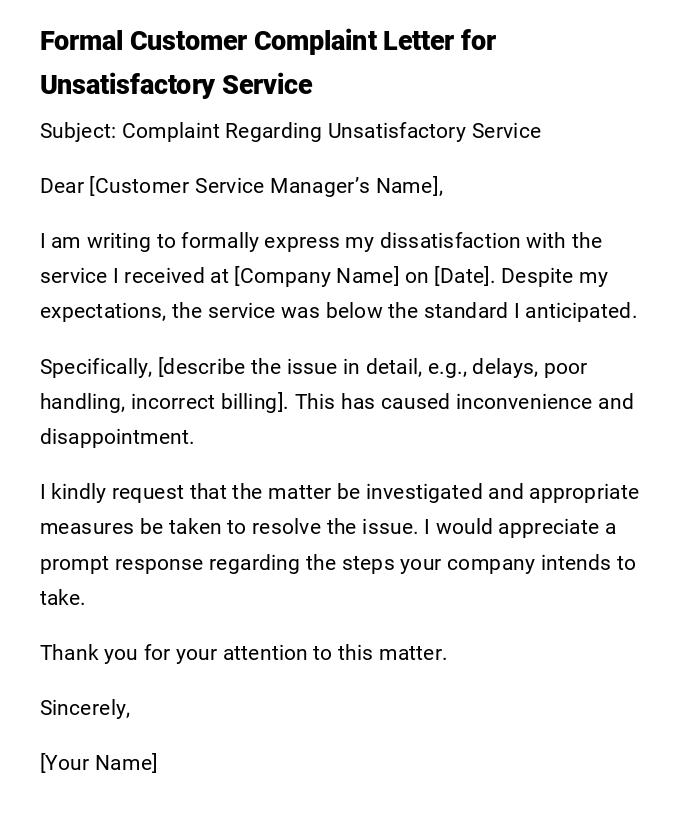
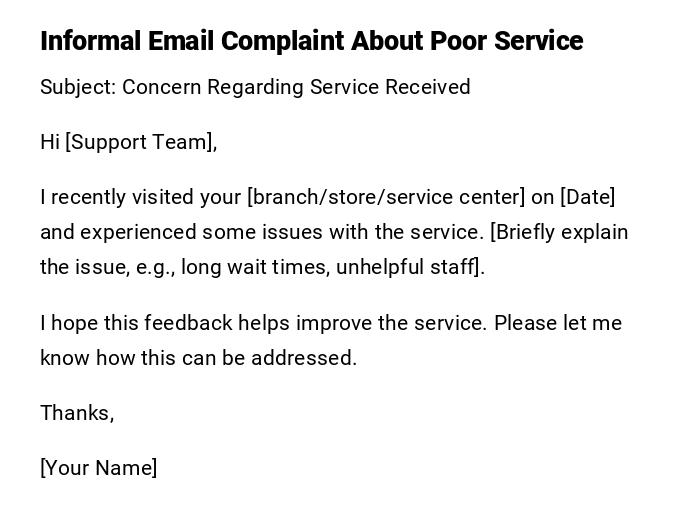
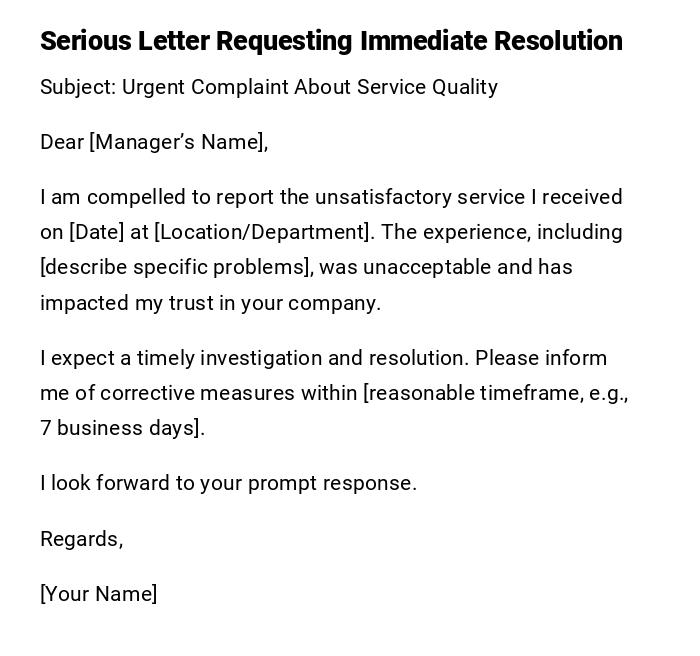
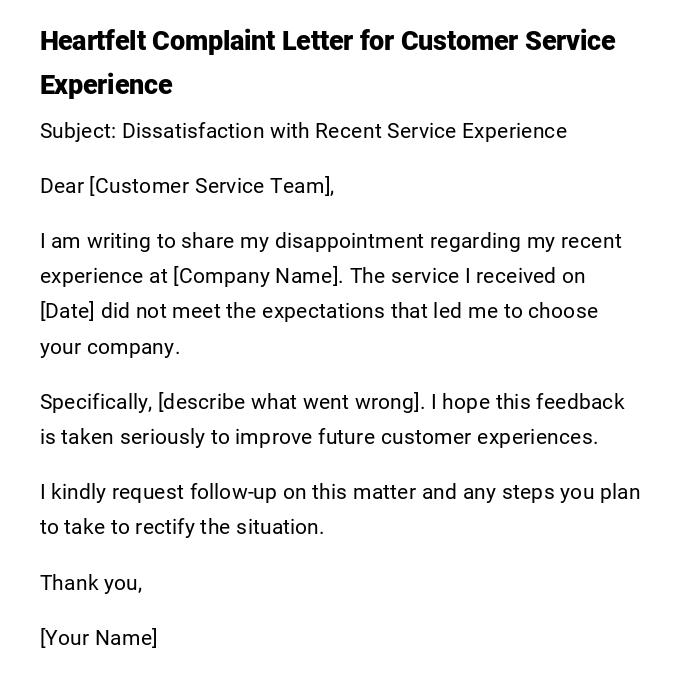
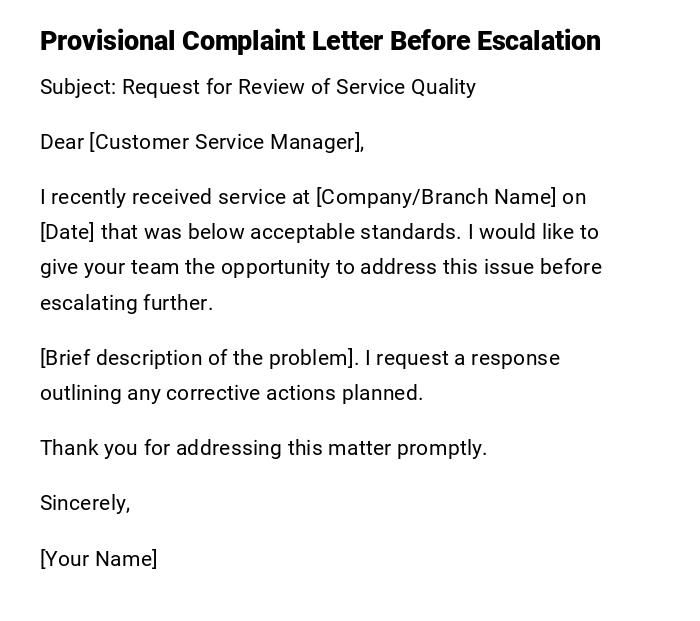
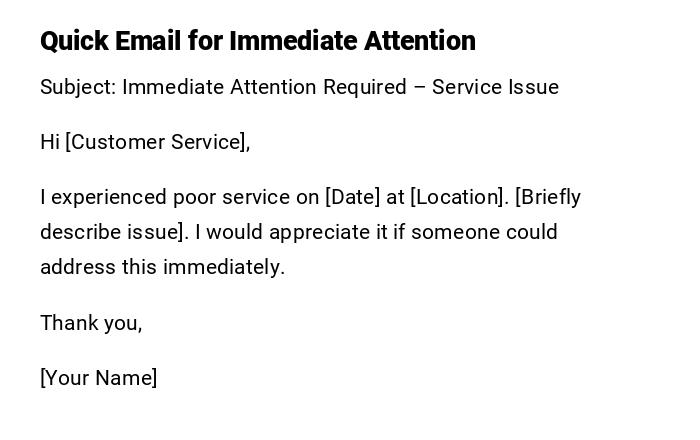
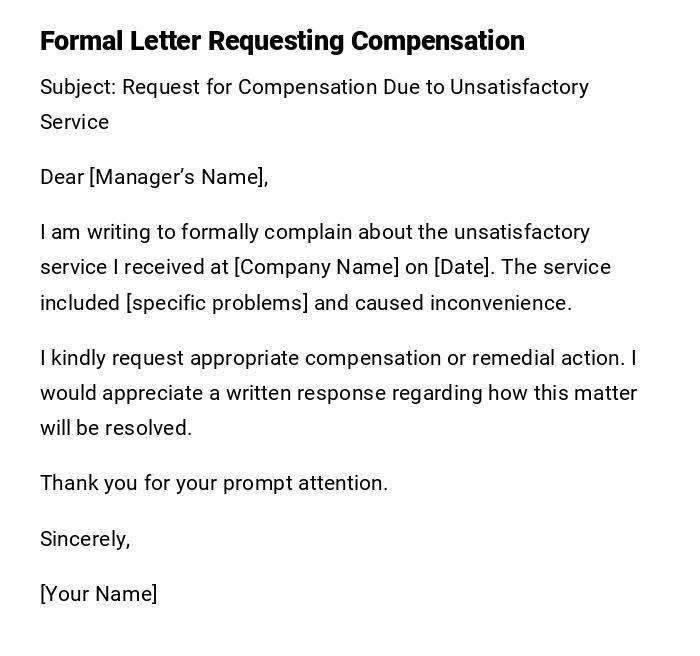
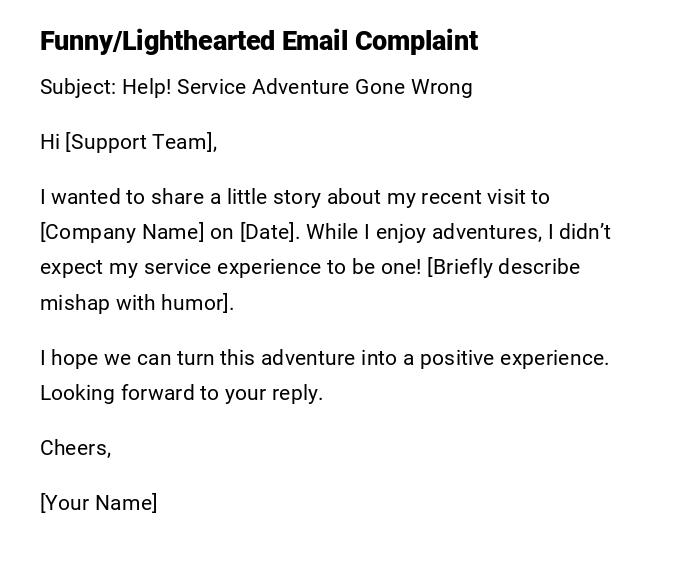
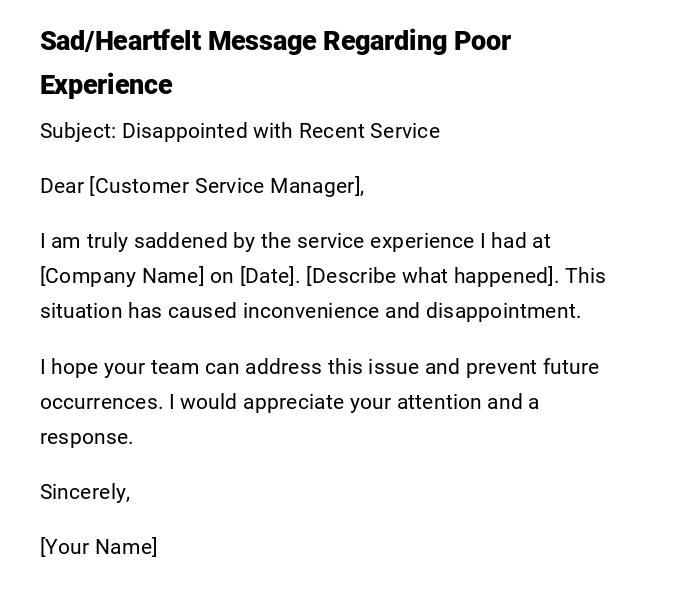

 Download Word Doc
Download Word Doc
 Download PDF
Download PDF